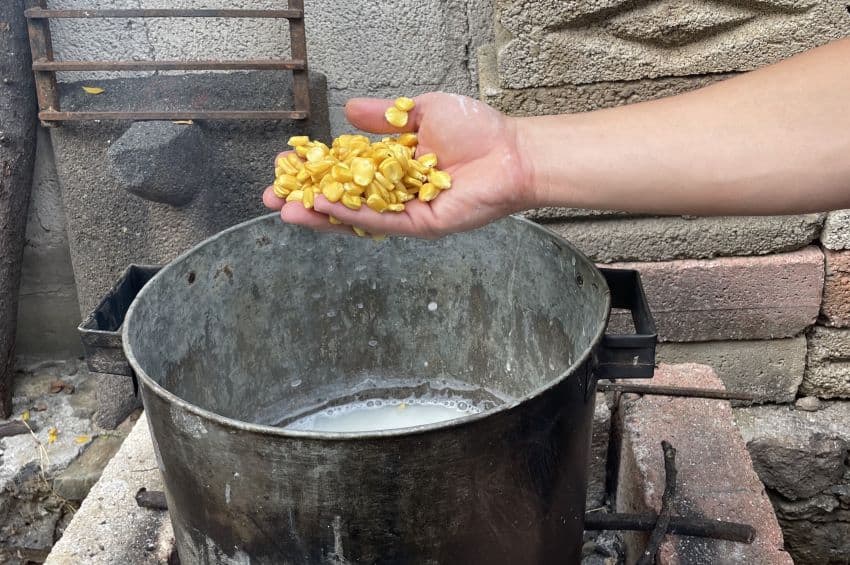With the prevalence of GM corn impacting the way people eat, learn how Mexico’s intercultural complexity and food wealth is preserved through chemical-free maize farming techniques long before “organic” became trendy.
Graciela Olivares, a 69-year-old woman from the small town of Amatlán de Quetzalcoatl in the Mexican state of Morelos, is known for continuing the tradition of the famous milpa, a millenary system based on polycultures that involves growing corn, beans and squash together in one place. For those fascinated by the richness and diversity of Mexican culture, corn is a key topic, as many historians argue that maize is also the cornerstone of Mexican civilization.

In fact, the milpa is the foundation of Mexico’s ancient cuisine, which was recognized as Intangible Cultural Heritage by UNESCO in 2010. Maize, in particular, is found in many diverse forms such as atole, cereal, chilaquiles, chimole, esquites, huitlacoche, molotes, enchiladas, panuchos, peneques, pinole, sopes, tamales, tacos, tlayudas, and, of course, tortillas.
Graciela was born in Milpa Alta, one of the last rural areas within Mexico City. In the past, Milpa Alta was known for growing maize criollo, which was the main agricultural activity in the area. In recent years, however, Milpa Alta has become the country’s main producer of nopal, or cactus.
Graciela has fond memories of criollo corn, a type of maize that has been improved over thousands of years through selection and exchange between Milpa Alta’s inhabitants. Graciela grew up in a family where everyone helped cultivate the milpa, and this tradition continued when she moved to Amatlán de Quetzalcótal with her husband over 50 years ago.
However, things are changing, and the new generations no longer have an interest in working the land.
“The young people don’t see the value of this beautiful corn, of growing their own maize, which is natural, free of chemicals, healthy and delicious,” Graciela told Mexico News Daily.
An organic process thousands of years old

For thousands of years, Mexicans grew criollo corn in a completely organic and healthy way. According to the Food and Agriculture Organization of the United Nations (FAO), organic food is the result of an environmentally friendly agricultural process that does not use fertilizers, pesticides or chemicals on the soil that is harvested: exactly the way the milpa was managed at least until the middle of the 20th century.
According to Graciela, however, many of the villagers in Milpa Alta have stopped using criollo corn, adding insecticides to make the job easier. “I don’t like to use herbicides or chemicals, I feel that if I do, I am poisoning the earth,” she explained.
Without herbicides, Graciela and her assistants have to cut all of the weeds that grow around the milpa by hand — a much harder job. Even so, she feels she is doing the right thing.
Not only is Graciela a guardian of organic corn, but she is also a keeper of the ancient process of nixtamalization used to make tortillas. This process, which consists of adding limestone to a boiling pot of harvested maize, is over three thousand years old. This tradition increases the nutritional properties of corn like calcium, iron and vitamin B3.
During the nixtamalization process, chemical changes occur that make the dough more malleable. In addition, the kernel absorbs calcium and potassium. Heating nixtamalized tortilla dough causes changes in the corn’s main proteins, making the nutrients in the kernel’s endosperm more digestible by the human body.
“The criollo corn, [aided by] nixtamalization makes the tortilla delicious. [The process] also improves its taste, smell and texture. We need to share this knowledge: I think that you are less vulnerable making your own food this way,” said Graciela.
So, why are organic criollo corn and food processes like nixtamalization important? According to the Pan American Health Organization, Mexico leads Latin America in the consumption of ultra-processed products, at 214 kilograms of processed food per person per year. This is indeed a cause for concern, as studies have linked this consumption to diseases such as cancer and diabetes.
Additionally, the use of pesticides in Mexico is alarming. According to the National Institute of Ecology and Climate Change (INECC), the most commonly used pesticides in Mexico are banned in 34 countries. This highlights the need for more sustainable and organic farming practices to reduce the use of harmful chemicals and protect both human health and the environment.
In this context, the people who preserve native seeds and practice traditional organic methods are indeed playing a crucial role. Not only are they preserving biodiversity and traditional knowledge, but they are also promoting healthier and more sustainable food production. These individuals can be seen as contemporary heroes, as they are contributing to the well-being of their communities and the planet as a whole.
A growing trend: conserving native seeds

Graciela Olivares is not alone; in recent years, there has been a growing interest in preserving native seeds in Mexico. Projects like La Casa del Maíz keep more than 45 of the 64 criollo corn varieties in existence, according to the Agriculture and Rural Development Ministry (SADER). The Mexican government has also documented at least 26 community seed banks across the country.
Furthermore, government initiatives such as the germplasm banks of the National Center for Genetic Resources (CNRG) play a crucial role in preserving criollo seeds. These initiatives ensure that the genetic diversity of crops is conserved for future generations.
Thanks to the efforts of individuals like Graciela and the support of government initiatives and organizations, Mexico’s criollo corn safeguards the cultural and culinary traditions of this country that have been passed down for thousands of years.
Ana Paula de la Torre is a Mexican journalist and collaborator of various media such as Milenio, Animal Político, Vice, Newsweek en Español, Televisa and Mexico News Daily.
